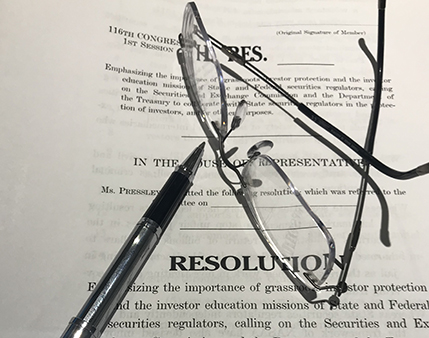Oct. 2, 2023
The SEC’s Office of Investor Education and Advocacy (OIEA), the Financial Industry Regulatory Authority (FINRA), the Commodity Futures Trading Commission (CFTC), the National Futures Association (NFA), the Securities Investor Protection Corporation (SIPC), and the North American Securities Administrators Association (NASAA) are issuing this Investor Bulletin to provide investors with information about the three themes of World Investor Week 2023, a global campaign promoted by the International Organization of Securities Commissions (IOSCO) to raise awareness about the importance of investor education and protection.
Investor Resilience
A resilient investor plans for life’s unexpected challenges with budgeting strategies to manage risk, reduce the impact of inflation, and avoid high-interest debt. If you want to improve your resilience as an investor, here are three tips to consider:
1. Diversify your investments.
Diversification is a strategy where you spread your money among different investments to reduce your overall investment risk. The idea is that if one investment loses money, the other investments can make up for those losses — like the saying “Don’t put all your eggs in one basket.” By picking the right mix of investments, you might be able to limit your losses and reduce the fluctuations of your investment returns without sacrificing too much in potential gains. Also, carefully consider how much, if any, of your portfolio to devote to speculative or complex investments.
A diversified portfolio should be diversified at two levels: between asset categories and within asset categories. So, in addition to allocating your investments among stocks, bonds, cash equivalents, and possibly other asset categories, you also should consider spreading out your investments within each asset category.
| Check that your securities account is held by a SIPC-member broker by using the membership list on sipc.org. If your broker fails, SIPC protects you by working to return covered securities and related cash to customers, advancing up to $500,000 ($250,000 of which might be for cash claims) to restore missing customer property. |
The key is to identify investments in segments of each asset category that might perform differently under different market conditions. For example, the value of some investments might be negatively impacted by inflation, a general upward movement in prices. Inflation reduces purchasing power, which is a risk for investors receiving a fixed rate of return. Inflation also can lead to higher interest rates and, in turn, lower market value for existing bonds. The value of other investments might be positively impacted by inflation.
Some investors find it easier to achieve diversification through ownership of mutual funds or exchange-traded funds (ETFs) rather than through ownership of individual stocks or bonds.
To learn more, read FINRA: Asset Allocation and Diversification.
2. Eliminate high-interest debt and have an emergency fund.
Consider making a plan that helps you pay off high-interest debt and build emergency savings as you invest.
No investment strategy consistently pays off as well as, or with less risk than, eliminating high interest debt. And, having adequate emergency savings will help you weather financial shocks without turning to credit or selling investments when you don’t want to.
Most credit cards charge high interest rates — as much as 18% or more — if you don’t pay off your balance in full each month. No investment will give you guaranteed returns to outweigh the high interest rate you generally pay with a credit card or other high-interest debt.
An emergency fund is rainy-day money you keep in a bank or credit union to use if you have an unexpected expense, like a cracked phone screen, car repair, or family emergency. If you don’t have an emergency fund, even a small financial upset can result in a long-term debt.
To save enough money to have a buffer for life’s unexpected expenses:
- set a savings goal, such as three to six months of living expenses;
- take advantage of one-time opportunities, such as tax refunds or gift money; and
- save automatically, such as by setting up a direct deposit to a savings account with each paycheck.
3. Look out for investment frauds and scams.
Investment fraud comes in many forms. For example, fraudsters may exploit social media, celebrity endorsements, and impersonations to lure investors into scams.
Be aware that fraudsters might contact potential victims on social media platforms — including professional networking, dating, and messaging websites/apps — or through unsolicited text messages or opportunities to trade using “other people’s money.” A fraudster might first pretend to be an old friend or claim to have contacted you accidentally. They might then initiate a friendship or romantic relationship with you to gain your trust, and convince you to invest your money before they disappear with the funds. Do not invest money based on advice from someone you have solely met online or through an app.
Investors should not make investment decisions based on endorsements by celebrities or so-called social media “finfluencers.” While there is nothing new about marketers paying celebrities to endorse their products, a celebrity endorsement does not mean that an investment is legitimate or that it is appropriate for all investors. Celebrities, like anyone else, must disclose that they are getting paid to promote investments in securities. And celebrities, like anyone else, can be lured into participating (even unknowingly) in a fraudulent scheme. Also, celebrities are sometimes linked to products or services without their consent so the celebrity may not even have endorsed the investment.
You should also keep an eye out for impersonation schemes. Fraudsters often impersonate organizations or individuals to lure victims into scams, including through ‘deep-fakes’ that use new technologies to create convincing voice and video imitations. They might impersonate government agencies or employees, or legitimate investment professionals like brokers and investment advisers. Impersonators might be part of an advance fee scam, or might use personal information they obtain to steal an individual’s identity or misappropriate their financial assets. Safeguard all information relating to your personal finances or identity including your bank or brokerage account information, tax forms, credit card, Social Security number, passport, driver’s license, birthdate, or utility bills.
| High guaranteed returns are a hallmark of investment fraud. Be skeptical of any investment opportunity that promises high investment returns with little or no risk. Learn how to spot red flags of an investment scam on the SEC’s HoweyTrade webpage. |
Here are two easy steps you can take to help protect yourself from losing money to an investment scam:
- Check that anyone offering or selling you an investment is licensed or registered. You can do this by using the free and simple search tools on gov, BrokerCheck,and BASIC. You might also contact your state or provincial securities regulator.
- Verify that an investment professional is who they say they are. For example, contact the professional using a phone number or website listed in the firm’s Client Relationship Summary (Form CRS), a form that your adviser or broker is required to deliver to you and that you can findusing the free and simple search tool on gov.
To learn more about top investor threats and warning signs of fraud, visit NASAA Fraud Center.
Crypto Assets
Investors should be aware that:
- Investments in crypto assets can be exceptionally volatile and speculative, and the platforms where investors buy, sell, borrow, or lend these investments might lack important protections.
- Those offering crypto asset investments or services may not be complying with applicable law, including federal securities laws.
- Investors who deposit funds or crypto assets with a crypto asset entity might cease to have legal ownership of those assets and might not be able to get those assets back when they want to.
- Unregistered offerings may not provide key information that investors need to make informed decisions.
- Crypto asset securities held by a securities broker may not be protected by SIPC if the broker fails and is liquidated.
- Fraudsters continue to exploit the rising popularity of crypto assets to lure retail investors into scams, often leading to devastating losses.
- Finding out if your portfolio (including your retirement plans and investment accounts) holds any crypto asset-related investments requires you to take an active role in researching and asking questions. Investors should understand if they are being exposed to risky investments involving crypto assets.
The risk of loss for individual investors who participate in transactions involving crypto assets, including crypto asset securities, remains significant. The only money you should put at risk with any speculative investment is money you can afford to lose entirely.
If you are considering a crypto asset-related investment, take the time to understand how the investment works and look for warning signs that it may be a crypto asset investment scam. Carefully review all materials, ask questions, and watch for the signs of a fraudulent trading website. Check out the background (including license and registration status) of anyone offering you an investment in securities using the search tools on Investor.gov and BrokerCheck. Use NFA’s BASIC system to research the background of derivatives industry firms and professionals.
Learn more about investments involving crypto assets on Investor.gov or CFTC.gov.
Sustainable Finance
Sustainable investing, socially responsible investing, and impact investing generally refer to “ESG” (Environmental, Social, and Governance) investing — a way of investing in companies based on their consideration of one or more ESG factors.
- The environmental factor might focus on a company’s impact on the environment or the risks and opportunities associated with the impacts of climate change on the company, its business, and its industry.
- The social factor might focus on the company’s relationship with its workforce, communities in which it operates, or its impact on society more generally.
- The governance factor might focus on issues such as how the company is run and executive compensation.
Investments may vary widely in their approach to sustainable investing. They may weigh environmental, social, and governance factors differently or may focus on different criteria within a factor. Investments that don’t have “ESG” in their name may still incorporate elements of ESG investing into their portfolios. On the other hand, if an investment has a term like “ESG” or “sustainable” in its name, don’t automatically assume it is right for you — it is always important to understand what you are investing in, and to be sure the investment is a good match with your investment goals.
There are funds that focus on ESG principles. To learn more about these funds, read Environmental, Social and Governance (ESG) Funds.
***
If you have questions about your investments or your investment professional, or want to report possible misconduct, you can contact your state securities regulator. You can call the SEC’s investor assistance line at (800) 732-0330. You can also report a problem concerning your investments or report possible securities fraud to the SEC, or by emailing Help@SEC.gov. For a derivatives-related complaint (involving futures, options on futures, forex or swaps) involving a pending, current, or former NFA Member (as displayed in BASIC), file with NFA.
Follow us on X and Facebook and sign up for email updates on investing-related topics and news.
Additional Resources
NASAA has provided this information as a service to investors. It is neither a legal interpretation nor an indication of a policy position by NASAA or any of its members, the state and provincial securities regulators. If you have questions concerning the meaning or application of a particular state law or rule or regulation, or a NASAA model rule, statement of policy, or other materials, please consult with an attorney who specializes in securities law.













